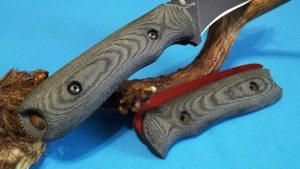Schrade SCHF42 Frontier Fixed Blade Knife Reviewed
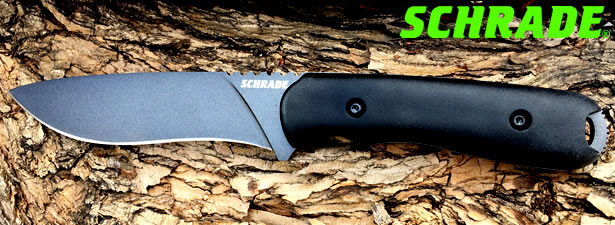
Marketing from Schrade
The Griffin Design SCHF42 combines rugged great looks with functional reliability. Nearly ten inches in length, the knife enjoys the multiple benefits of a full tang forged from easily sharpened 1095 high carbon steel. The sharp tip of the drop point blade offers powerful piercing strength. The 5.12 inch fine edge, with a slight recurve as it approaches the handle, arrives slicing sharp straight from Schrade.
Deeply grooved jimping on the blade’s thick steel spine gives you a solid platform for exerting added down force and increases blade control no matter the cutting task. The iconic Griffin Design logo appears just below the jimping. The 4.83 inch grivory handle slabs are heat, chemical, abrasion, and corrosion resistant and are solidly attached to the full tang by dual steel bolts. The tang’s end extends through the contoured handle to form a crushing tool… as well as providing a lanyard hole.
Sheath the SCHF42 in the black premium leather grommet reinforced belt sheath. The generous loop accommodates belts of nearly any size and the single snap strap makes for easy access.
A Griffin Design knife for discriminating outdoorsman… crafted from premium materials… and built for a lifetime… this is the Schrade SCHF42 Frontier series full tang fixed blade survival knife.
Manufacturer: Schrade, www.schrade.com
Model: SCHF42
Overall Length: 9.95 inch (25.27 cm)
Blade Steel: 1095 High Carbon Steel
Blade Length: 5.12 inch (13.00 cm)
Blade Thickness: 3/16 inch (4.76 mm)
Handle Material: Grivory Handle Slabs
Handle Length: 4.83 inch (12.27 cm)
Weight: 8.6 oz. (244 g)
Accessories: Leather Sheath
Warranty: Limited Lifetime Warranty against any manufacturing defects
Origin: Made in Taiwan
UPC: 044356223976
MSRP: $75.56
The Review
Schrade’s SCHF42 Frontier Fixed Blade Knife is one of the latest additions to their 2015 Frontier Series lineup. Designed by Brian Griffin, this full-tang 1095 high carbon steel blade with grivory handle slabs and a premium leather sheath is certainly on track to be one of their most popular models of the year.

Initial Thoughts
I was pretty excited when the package arrived at my door with Schrade’s new SCHF42 inside. The anticipation was high for this one. Especially after learning that it was designed by Brian Griffin who was also the designer my beloved SCHF9. There are loads of striking features packed into the SCHF42 from its powder coated full-tang 1095 high carbon steel blade to its slightly textured black grivory handle slabs and premium quality black leather belt sheath.
The SCHF42 is an attractive recurved full-tang design pattern sized perfectly as a crossover blade landing somewhere in between a survival knife and a bushcraft knife. The Grivory handle material is lightly textured and very comfortable to wield with or without gloves.
The SCHF42 is full-tang and made from 1095 high carbon steel blade with distal taper and an attractive powder coated finish. The jimping on the spine feels excessively aggressive. I feel that it might be better if the ridges were not as sharp. The pommel also has aggressive knurling to prevent slippage when it is being used.
The premium black leather belt sheath with grommet-reinforced edges and a belt loop capable of accommodating a belt as wide as 3.5″. There is a single snap strap to provide easy access and secure the blade when it’s not in use.
Features
Now lets focus on the SCHF42’s features in greater detail…
The Blade
Schrade’s SCHF42 is a rugged medium-sized full-tang blade made from a solid 3/16″ piece of 1095 high carbon steel running throughout. Weighing only 8.6 ounces, it has an overall length of 9.95″ and a blade length of 5.12″. Its full-tang design provides all of the strength and rigidity that you would expect from any good survival knife.
 1095 high carbon steel is one of the most popular tool steels available for survival blades due to the fact that it is much harder than other steel and stainless steel alloys, and it tends to hold an edge much longer even after taking a licking. Not to mention, it is typically easier to sharpen than comparable steel and stainless alloys making it an excellent choice for a survival blade.
1095 high carbon steel is one of the most popular tool steels available for survival blades due to the fact that it is much harder than other steel and stainless steel alloys, and it tends to hold an edge much longer even after taking a licking. Not to mention, it is typically easier to sharpen than comparable steel and stainless alloys making it an excellent choice for a survival blade.
Schrade’s SCHDDS diamond dust knife sharpening rod is perfect for tuning the blade’s edge in the field. However, be careful not to leave striations down the length of the blade. This will cause it to dull much faster, as opposed to perpendicular striations that are left by most stone sharpening methods.
The only real drawback to 1095 high carbon steel is its susceptibility to rust without proper care and maintenance. Even with a protective powder coating. However, by keeping the SCHF42 dry and lightly oiled when not in use, it will likely last you a lifetime and then some.
The SCHF42 features an attractive drop-point blade pattern with a modest recurved edge, a distal taper, and a full-flat grind with no serrations.
Many blade types including the drop point, clip point, and even a hawkbill can have a recurve. A recurve generally refers to a blade with a sweeping “S” shaped edge which is best described as a blade characteristic or feature rather than a blade shape. Recurved blade patterns are often used to improve the balance of blades designed for chopping. They tend to enhance a blade’s ability to bite deeply into the target material when chopping, slicing and slashing.
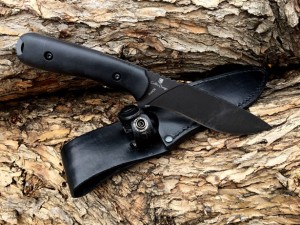 Additionally, recurved blades typically perform quite well on bushcraft tasks like draw-cutting, notching and shaving sticks particularly due to the concave curvature which changes the angle of the blade’s edge. Unfortunately, recurved blades can be more challenging to sharpen with a stone due to the inward curvature (or recurve) of the blade’s edge toward the heel of the blade.
Additionally, recurved blades typically perform quite well on bushcraft tasks like draw-cutting, notching and shaving sticks particularly due to the concave curvature which changes the angle of the blade’s edge. Unfortunately, recurved blades can be more challenging to sharpen with a stone due to the inward curvature (or recurve) of the blade’s edge toward the heel of the blade.
One of the most unique features of the SCHF42 among the rest of Schrade’s 2015 lineup is its distal taper, an advanced design characteristic often embraced by olde world knife and sword makers. Distal tapering refers to the gradual reduction of a blade’s thickness from the guard to its tip resulting in a blade that is not only lightweight and easy to wield, but also provides its superior piercing capabilities.
The SCHF42’s full-flat grind consists of a gradual taper located on both sides of the blade from the spine to its edge resulting in its beautiful edge geometry. Full-flat grinds are not very common commercially due to the amount of material that must be removed by grinding so it is a design characteristic that is typically only found on higher-end cutlery.
Jimping is a term used when describing the small notches cut into the back of a blade to prevent your fingers from sliding when using the knife. The SCHF42 features six deep notches cut into the top of the spine just beyond the handle for a variety of gripping options. This jimping seems too aggressive from the factory and will likely require some effort to tone it down some.
The Handle
The SCHF42’s two 4.83″ handle slabs are made from an extremely durable material called Grivory which is a glass-filled nylon-based thermoplastic. Grivory, also known as Polyphthalamide is a synthetic thermoplastic resin that is often used to replace metals in high temperature electrical applications requiring high mechanical strength and thermal resistance which is why it is an attractive material for cutlery.
The two Grivory halves of the handle are attached through the tang with two recessed allen bolts threaded directly into the knife steel allowing it to absorb much of the shock when chopping or batoning, thereby reducing fatigue. The handle’s ergonomic design is lightly textured and well-contoured with an index finger groove and a moderate palm-swell making it easy to hold on to wet or dry, with or without gloves.
The SCHF42 has an elongated lanyard hole located at butt of the handle just above the pommel for a variety of tethering options. The pommel has some very aggressive jimping to prevent slippage when striking material.
The Sheath
The SCHF42 comes with a durable premium black leather belt sheath with grommet-reinforced edges and a belt loop capable of accommodating a belt as wide as 3.5″. There is a single snap strap to provide easy access and secure the blade when it’s not in use.

Functional Testing
Now lets see what the SCHF42 can do… In order to provide a some sort of apples-to-apples comparison between blades, I will be performing five durability tests; Batoning, Chopping, Feathering A Stick, Tip Strength and Edge Retention. In a survival situation, all resources are fair game. However, since I am not in a life-or-death situation, I’ll stick to some dead wood that I have lying around for these tests.
Batoning
Per Wikipedia: Batoning is the technique of cutting or splitting wood by using a baton-sized stick or mallet to repeatedly strike the spine of a sturdy knife, chisel or blade in order to drive it through wood. The batoning method can be used to make kindling or desired forms such as boards, slats or notches. The practice is most useful for obtaining dry wood from the inside of logs for the purpose of fire making.
For this test, I chose to split a couple of 3″ logs approximately 12″ in length. I felt this would be the perfect size as the SCHF42 only has a 5″ blade. To demonstrate splitting material into kindling any larger than 3″ in diameter doesn’t really serve any purpose to me.
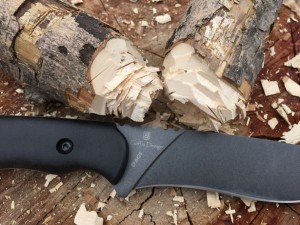 I used the baton to strike the long-flat spine of the SCHF42 first splitting the logs in half, then in quarters followed by splitting each piece a few more times until they were small enough. Before I knew it, I was done with both logs and I had a few dozen small pieces of kindling. The blade is very sharp and the full-flat grind has a smooth and gradual taper allowing the blade to glide through the material with ease. Even through the knotty stuff.
I used the baton to strike the long-flat spine of the SCHF42 first splitting the logs in half, then in quarters followed by splitting each piece a few more times until they were small enough. Before I knew it, I was done with both logs and I had a few dozen small pieces of kindling. The blade is very sharp and the full-flat grind has a smooth and gradual taper allowing the blade to glide through the material with ease. Even through the knotty stuff.
Chopping
To test the SCHF42 at its ability to chop material I began chopping at material of all different sizes, working my way up from 1″ in diameter all the way to material about 3″ in diameter. Any larger than that, you are definitely better off using a hand axe or hatchet. However, if the SCHF42 is all you’ve got, just find some smaller material instead.
For a 5″ blade, Schrade’s SCHF42 performs quite well at chopping material. Its a long distal taper and a very sharp recurved cutting edge help it to penetrate more deeply into the material that you are chopping with each swing. The SCHF42 was able to chop through much of the smaller material with a single swing or two and through the larger stuff with a few more than that. I was quite impressed with its ability to remove material.
Feather Stick
Per Wikipedia: A feather stick (sometimes referred to as a fuzz stick) is a length of wood which is shaved to produce a head of thin curls protruding from the wood. It is used for damp wood to start a fire (or campfire) when dry tinder is hard to find.
Feathering a stick is certainly the one test that I expected the SCHF42 to excel at most of all. Its size, balance and blade characteristics are exceptional for fine blade control. For this test I chose a fir stick about 1″ in diameter and around 12″ in length. I am sure any soft woods would work equally as well. I began the test by taking long 5-6″ strokes around the bottom-end of the stick creating finely shaved curls otherwise known as “feathers”. I found that the area just behind the belly of the blade in the recurved area to be the sweet-spot where I was able to create the finest shavings with the least amount of effort.
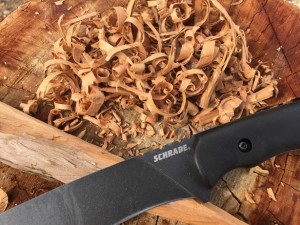 As I made my way around the stick I was very careful not to dig in too deeply so the curls would be as long and thin as possible. Before long I had a tall pile of shavings perfect for starting a fire. In the end, I was very happy with the results of the test. The SCHF42 performed exceptionally well, even with its original factory edge.
As I made my way around the stick I was very careful not to dig in too deeply so the curls would be as long and thin as possible. Before long I had a tall pile of shavings perfect for starting a fire. In the end, I was very happy with the results of the test. The SCHF42 performed exceptionally well, even with its original factory edge.
Tip Strength
To test the SCHF42’s ability to stab and pierce without bending or breaking the tip, I drove the blade into the end of a 12″ stump with a baton about an 1-1/2″ deep. Then I loosened the blade using a side-to-side motion until it became loose enough to pull out. I repeated this test a few more times without any sign of chipping or tip damage. As I was performing this test, I noticed that the distal taper really does improve the blade’s ability to stab and pierce.
Next, I used the SCHF42 to bore a hole into the side of a 3″ log approximately 1″ in diameter and about 1″ deep by twisting the blade back and forth. The SCHF42’s sharp, aggressive tip performed this task flawlessly.
Edge Retention
After all of the other functional testing was complete, the SCHF42 was still able to slice cleanly through a single sheet of paper without issue. Testing left no sign of cracks, chips or imperfections of any kind with the exception of some slight wear on the blade’s protective coating. The SCHF42 held its edge and remained very sharp through the entire process.
Final Thoughts
Now that I’ve had the opportunity to use Schrade’s SCHF42 for a few of months, I can honestly say that it has met or exceeded all of expectations and then some. Its moderate size, comfortable handle and terrific balance make it very easy to wield. This coupled with its distal taper and recurved cutting edge provide exceptionally fine blade control. As a result, the SCHF42 is perfectly capable of performing well at survival tasks like splitting small logs and feathering sticks, to more advanced bushcraft techniques like whittling trap triggers, and even skinning animals.
The only issues I found would certainly not be considered showstoppers to me. First, the jimping is a little too aggressive. This will likely smooth out over time, but it can easily be taken care of with a fine file or a wire wheel. Second, the protective coating quickly wears off and stuff tends to get stuck to it. Many knife enthusiasts tend to remove the coating anyway.
I found Schrade’s SCHF42 to be a solid performer from tip to pommel, and when it comes to tactical, survival and bushcraft knives the SCHF42 shares a high-level of quality and characteristics similar to those of knives twice its price. Therefore, if I ever found myself in a position where I could only afford to carry a single fixed-blade knife, the SCHF42 would certainly be way up on my list.
I would love to be able to purchase various replacement scales in Grivory, TPE, G10 and of course Micarta for all of Schrade’s fixed-blade knives that have removable handle slabs, but especially for the SCHF42. It would also be nice to see various sheath options available too. Hopefully Schrade will make that happen someday. In the meantime, there are third-party options available.
You can find this and other Schrade products here: http://amzn.to/2c0kjZF
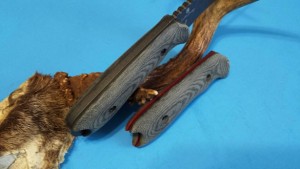 UPDATE:
UPDATE:
I have since received my beautiful custom Micarta scales fabricated by Joe Snarski at LMF Knives special for the SCHF42… Be sure to stop by the LMF Knives Facebook page at https://facebook.com/LMFknives and give them a like!
![]()
About Taylor Brands and Schrade Cutlery
 Founded by Stewart Taylor in 1975, Taylor Brands has been manufacturing, designing, and distributing high-quality stainless steel cutting tools and accessories since our inception. Taylor Brands owns and produces Schrade, Old Timer, Uncle Henry, and Imperial branded products, and are also licensed to produce multiple product lines under the world famous Smith & Wesson brand. In total Taylor Brands manufactures several hundred different products including fixed and folding knives, collapsible batons, tactical pens, handcuffs, tactical and survival accessories, and flashlights.
Founded by Stewart Taylor in 1975, Taylor Brands has been manufacturing, designing, and distributing high-quality stainless steel cutting tools and accessories since our inception. Taylor Brands owns and produces Schrade, Old Timer, Uncle Henry, and Imperial branded products, and are also licensed to produce multiple product lines under the world famous Smith & Wesson brand. In total Taylor Brands manufactures several hundred different products including fixed and folding knives, collapsible batons, tactical pens, handcuffs, tactical and survival accessories, and flashlights.
--
